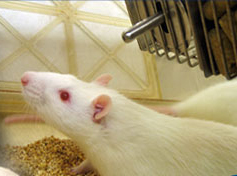Knockout rat
Knockout rat refers to a genetically modified organism (GMO) rat in which one or more genes have been turned off, or "knocked out," through a process known as gene knockout. This genetic manipulation is used for scientific research to study the role of specific genes in health and disease. The knockout rat is a valuable model for understanding genetic diseases, physiology, and drug development, providing insights that can be relevant to human conditions.
Overview[edit | edit source]
The concept of a knockout rat involves the targeted disruption or modification of specific genes within the rat's DNA. This is achieved through various genetic engineering techniques, such as CRISPR-Cas9, which allows for precise editing of the genome. By knocking out a gene, researchers can observe the effects of its absence on the organism's development, behavior, and physiology, offering clues about the gene's function.
Applications[edit | edit source]
Knockout rats are used in a wide range of biomedical research areas. They are particularly valuable in studies related to genetic disorders, as they can mimic human diseases that are linked to specific genetic mutations. This makes them essential tools for understanding the pathophysiology of diseases, identifying potential biomarkers, and evaluating the efficacy and safety of new pharmaceuticals.
In addition to disease modeling, knockout rats are used in the study of gene function and gene regulation, as well as in research on complex traits such as behavior, aging, and metabolism. Their similarity to humans in physiological and genetic aspects makes them more relevant models than mice for certain types of research.
Techniques[edit | edit source]
Creating a knockout rat involves several steps, starting with the selection of the target gene to be knocked out. The most common method for gene knockout in rats has been the use of embryonic stem cells (ES cells) that are genetically modified in vitro and then introduced into rat embryos. However, the development of CRISPR-Cas9 gene-editing technology has revolutionized this process, offering a more efficient and precise means of creating knockout rats.
Ethical Considerations[edit | edit source]
The use of knockout rats, like other genetically modified animals in research, raises ethical questions regarding animal welfare and the potential long-term impacts on ecosystems should these organisms escape into the wild. Ethical guidelines and regulatory frameworks are in place to ensure that the use of knockout rats in research is justified, humane, and conducted with the utmost care to minimize suffering.
Conclusion[edit | edit source]
Knockout rats have become indispensable tools in biomedical research, offering valuable insights into the genetic basis of diseases and the potential effects of therapeutic interventions. As genetic engineering technologies continue to evolve, the creation and use of knockout rats are expected to expand, further enhancing our understanding of genetics and improving the development of treatments for human diseases.
Search WikiMD
Ad.Tired of being Overweight? Try W8MD's physician weight loss program.
Semaglutide (Ozempic / Wegovy and Tirzepatide (Mounjaro / Zepbound) available.
Advertise on WikiMD
|
WikiMD's Wellness Encyclopedia |
| Let Food Be Thy Medicine Medicine Thy Food - Hippocrates |
Translate this page: - East Asian
中文,
日本,
한국어,
South Asian
हिन्दी,
தமிழ்,
తెలుగు,
Urdu,
ಕನ್ನಡ,
Southeast Asian
Indonesian,
Vietnamese,
Thai,
မြန်မာဘာသာ,
বাংলা
European
español,
Deutsch,
français,
Greek,
português do Brasil,
polski,
română,
русский,
Nederlands,
norsk,
svenska,
suomi,
Italian
Middle Eastern & African
عربى,
Turkish,
Persian,
Hebrew,
Afrikaans,
isiZulu,
Kiswahili,
Other
Bulgarian,
Hungarian,
Czech,
Swedish,
മലയാളം,
मराठी,
ਪੰਜਾਬੀ,
ગુજરાતી,
Portuguese,
Ukrainian
Medical Disclaimer: WikiMD is not a substitute for professional medical advice. The information on WikiMD is provided as an information resource only, may be incorrect, outdated or misleading, and is not to be used or relied on for any diagnostic or treatment purposes. Please consult your health care provider before making any healthcare decisions or for guidance about a specific medical condition. WikiMD expressly disclaims responsibility, and shall have no liability, for any damages, loss, injury, or liability whatsoever suffered as a result of your reliance on the information contained in this site. By visiting this site you agree to the foregoing terms and conditions, which may from time to time be changed or supplemented by WikiMD. If you do not agree to the foregoing terms and conditions, you should not enter or use this site. See full disclaimer.
Credits:Most images are courtesy of Wikimedia commons, and templates, categories Wikipedia, licensed under CC BY SA or similar.
Contributors: Prab R. Tumpati, MD




